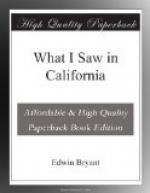The buildings and gardens belonging to this mission are in better condition than those of any of these establishments I have seen. There are two extensive gardens, surrounded by high walls; and a stroll through them afforded a most delightful contrast from the usually uncultivated landscape we have been travelling through for so long a time. Here were brought together most of the fruits and many of the plants of the temperate and tropical climates. Although not the season of flowers, still the roses were in bloom. Oranges, lemons, figs, and olives hung upon the trees, and the blood-red tuna, or prickly-pear, looked very tempting. Among the plants I noticed the American aloe (argave Americana), which is otherwise called maguey. From this plant, when it attains maturity, a saccharine liquor is extracted, which is manufactured into a beverage called pulque, and is much prized by Mexicans. The season of grapes has passed, but there are extensive vineyards at this mission. I drank, soon after my arrival, a glass of red wine manufactured here, of a good quality.
The mission of San Fernando is situated at the head of an extensive and very fertile plain, judging from the luxuriance of the grass and other vegetation now springing up. I noticed in the granary from which our horses were supplied with food many thousand bushels of corn. The ear is smaller than that of the corn of the Southern States. It resembles the maize cultivated in the Northern States, the kernel being hard and polished. Large herds of cattle and sheep were grazing upon the plain in sight of the mission.
January 12.—This morning two Californian officers, accompanied by Tortaria Pico, who marched with us from San Luis Obispo, came to the mission to treat for peace. A consultation was held and terms were suggested, and, as I understand, partly agreed upon, but not concluded. The officers left in the afternoon.
January 13.—We continued our march, and encamped near a deserted rancho at the foot of Couenga plain. Soon after we halted, the Californian peace-commissioners appeared, and the terms of peace and capitulation were finally agreed upon and signed by the respective parties. They were as follows:—
ARTICLES OF CAPITULATION,
Made and entered into at the Ranch of Couenga, this thirteenth day of January, eighteen hundred and forty-seven, between P.B. Reading, major; Louis McLane, junr., commanding 3rd Artillery; William H. Russell, ordnance officer—commissioners appointed by J.C. Fremont, Colonel United States Army, and Military Commandant of California; and Jose Antonio Carillo, commandant esquadron; Augustin Olivera, deputado—commissioners appointed by Don Andres Pico, Commander-in-chief of the Californian forces under the Mexican flag.
Article 1st. The Commissioners on the part of the Californians agree that their entire force shall, on presentation of themselves to Lieutenant-Colonel




